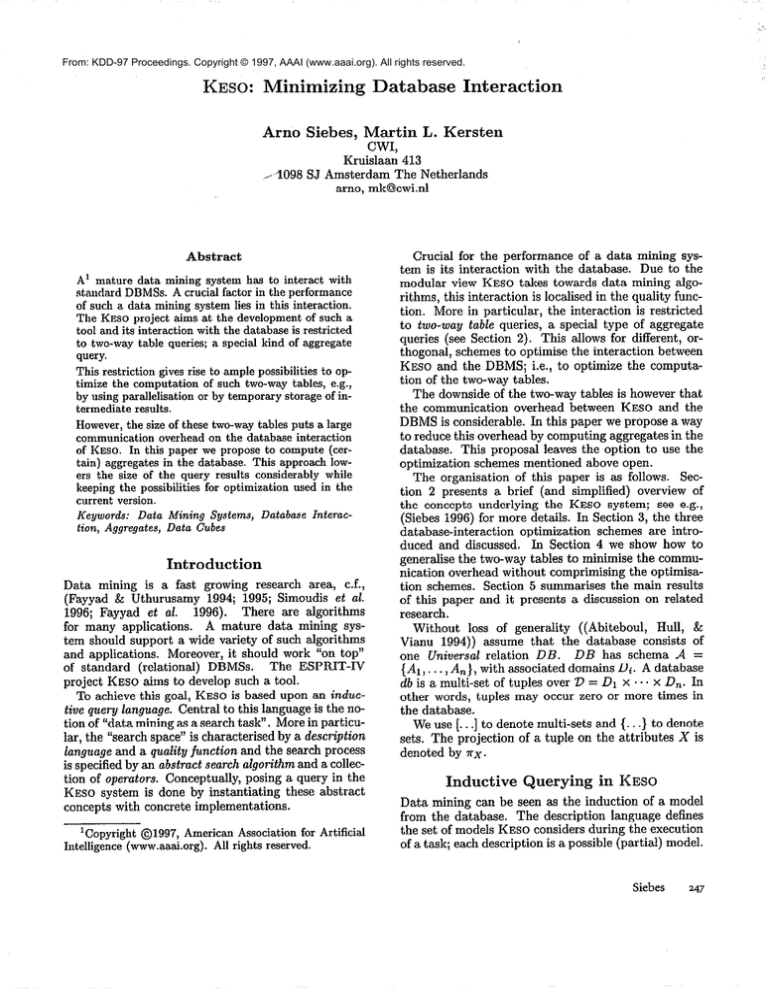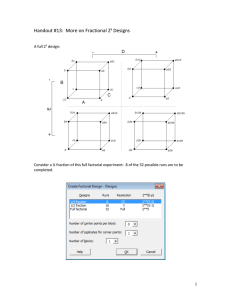
From: KDD-97 Proceedings. Copyright © 1997, AAAI (www.aaai.org). All rights reserved.
KESO: Minimizing
Arno
Database
Siebes, Martin
CWI,
Interaction
L. Kersten
Kruislaan 4i3
,-?I098 SJ Amsterdam The Netherlands
arno, mk@cwi.nl
Abstract
A’ mature data mining system ha.3to interact with
standard DBMSs. A crucial factor in the performance
of such a data mining system lies in this interaction.
The KEso project aims at the deveiopment of such a
tool and its interaction with the databaseis restricted
to two-way table queries;a special kind of aggregate
query.
This restriction gives rise to ample possibilities to optimize the computation of such two-way tables, e.g.,
by using parallelisation or by temporary storageof intermediate results.
However, the size of these two-way tables puts a large
communication overhead on the database interaction
of KESO. In this paper we proposeto compute (certain) aggregatesin the database.This approach low--- AL_
-r IL-__--_. re:su~~s
- --_.IL- c;u~s;luclavly
_^__:2---L,-. -..L:,ers
ixe -I-size 01
me query
w~me
keeping the possibilities for optimization used in the
current version.
Keywords: Data Mining Systems,DatabaseInteraction, Aggregates, Data Cubes
Introduction
Data mining is a fast growing research area, c.f.,
(Fayyad & Uthurusamy 1994; 1995; Simoudis et al.
1996; Fayyad et al. 1996). There are algorithms
for many applications. A mature data mining system should support a wide variety of such algorithms
and applications. Moreover, it should work “on top”
of standard (relational) DBMS% The ESPRIT-IV
project KESO aims to develop such a tool.
To achieve this goal, KESO is based upon an inductive query language. Central to this language is the notion of “data mining as a search task”. More in particular, the %earch space”is characterised by a description
languageand a quality function and the search process
is specified by an abstract search algorithm and a collection of operators. Conceptually, posing a query in the
vr-nEsO- system is done by instantiating these abstract
concepts with concrete implementations.
‘Copyright 01997, American Association for Artificial
Intelligence(www.aaai.org).All rights reserved.
Crucial for the performance of a data mining system is its interaction with the database. Due to the
modular view KESO takes towards data mining algorithms, this interaction is localised in the quality function. More in particular, the interaction is restricted
to two-way table queries, a special type of aggregate
queries (see Section 2). This allows for different, orthogonal, schemesto optimise the interaction between
KESO and the DBMS; i.e., to optimize the computation of the two-way tables.
The downside of the two-way tables is however that
the communication overhead between KESO and the
DBMS is considerable. In this paper we propose a way
to reduce this overhead by computing aggregatesin the
database. This proposal leaves the option to use the
optimization schemesmentioned above open.
The organisation of this paper is as foiiows. Section 2 presents a brief (and simplified) overview of
the concepts underlying the KESO system; see e.g.,
(Siebes 1996) f or more details. In Section 3, the three
database-interaction optimization schemes are introduced and discussed. In Section 4 we show how to
gene&se the two-way tables to minimise the communication overhead without comprimising the optimisation schemes. Section 5 summarises the main results
of this paper and it presents a discussion on related
research.
Without loss of generality ((Abiteboul, Hull7 &
Vianu 1994)) assume that the database consists of
one Universal relation DB. DB has schema A =
with associated domains Die A database
{4,...,An),
db is a multi-set of tuples over D = D1 x . -. x D,. In
other words, tuples may occur zero or more times in
the database.
We use [. . .] to denote multi-sets and {. . .} to denote
sets. The projection of a tuple on the attributes X is
denoted by mx.
Inductive
Querying
in KESO
Data mining can be seen as the induction of a model
from the database. The description language defines
the set of models KESO considers during the execution
of a task; each description is a possible (partial) model.
Siebes
247
The basic description ianguage for KESU is that of
selections. A selection for DB is a description of the
form:
in which r/i C_ Di. Such a selection description $ describes all tuples in the database that satisfy the selecgon
CQl?;&iOll;
$5. Fg’nr example,
age
E [l&241
A RPI! E
-1”---
{male} describes the young adult males in a database.
To restrict the selections, hierarchies Hi can be defined for each attribute Ai. Without loss of generality,
we can assume that such hierarchies have been defined
for all attributes. Thus Al E VI A .* * A A,, E V, is a
selection description for DB iff Vi E Hi.
Clearly, the selection description language depends
both on the database schema DB and on the hierar&&
&fined:
-However. , sincci
is
__ theqpl
1___L- twn
1.. _ _L
L ----- the
1--- -rnle
-_- nf
merely symbolic in this paper, the description language
of selection descriptions is denoted by simply Cp.
While the description language defines the models that KESO considers, the quality function determines how well a description (model) fits (part of) the
database. For the purposes of this paper we can forget issues as the syntactic compexity of a model and a
quality function & determines the quality of a description $ E @ hawwl
twn-mrn.w
~VPP
wnnnrt Y nf
YYUVU nn
Y.. .2 “WY
wwy tnhlp
“WV”” v.
VI thP
YI.V Ys”frJ,Y,
.,I
4. The support of 4 is simply that part of the database
that is described by 4. In other words, the support of
I#+denoted by (4) is defined by:
(ho = [t E dbI +(t>l
Two way tables have sets of source and target attributes, denoted by S and T with S,T C_ A. The
two-way table has as schema S U T U {Count}, where
Count has the natural numbers as domain. The tuples
in the two-way table over the support of 4 are those
tuples r that satisfy:
1. 3t E (4) : (VA E Su T : nA(t) = X,4(7-))
2. TC~~~~(T) = I[t E (4) 1VA E S u T : nA(t) = nA7-]I
The target attributes T are parameters that are set
by the quality function; in other words, T is constant
during a data mining task. The source attributes S
denote a context, S is variable during the execution of
the task, its value is set by the search strategy. For
given parameters S, T, 4, and db, the two-way table is
denoted by 2WT(S, T, 4, db)
.Tbe q,udity fun&ion & furt,har
_-____--comput,es so-meag
gregate function F over the two-way table, which yields
the final quality.
The quality function determines which descriptions
are the most interesting (i.e., which models are best),
finding these very interesting description is the task of
the KESO system. Sometimes the search space (i.e.,
the description language) is small enough to allow exhaustive search. Other times (such as for association
rlllcla~ t.hprp
“I.v*” ASP
-* ., nlm-wit.hma
y.o” Ay.A---y t;E.~~ fine! l;h~ np~imsi
--‘““I
sdll-
tion. Most often, however, heuristic approaches have
to be taken.
248
KDD-97
AI,
,.
HII tnese search aigorithms define (partiaij enumerations of the description language. More precisely, they
use a search strategy and operators on the description
language.
The search strategy defines the heuristic with which
the search space is enumerated. Examples are Exhaustive Search, Hill Climbing, Beam Search, and Genetic
Algorithms.
The operators implement the enumeration on the
search space. For example, a Hill Climbing algorithm
requires that the quality of the neighbours of the current best description 4 is computed. One way in which
the neighbours of a description could be defined is as
follows. For 4 = Al E VI A . . . A A, E V’, the neighbours of 4 is the set of descriptions
iA1 E ;;i;\.
. .AA,EW:,i3!iEjl,...
,nj
: ;;li~V~)
Or this set could be further restricted by requiring that
this particular lVi and Vi differ one step in the hierarchy Hi.
In KESO a data mining task on a database db is thus
specified by a four-tuple (!P’,&, S, 0) in which q is a
description language, & a quality function, S a search
strategy and 0 the set of operators on Q necessary for
c
ti.
The real power of KESO stems from the fact that we
can program using tasks as primitives. For example, if
Ar is a data mining task that discretizes a continuous
domain and As is a task that creates a classification
tree, Aa can use Ar whenever a continuous domain
is encountered. This allows Aa to “discretize on the
- 5; and use in each branch the discretization that is
fly
best for that branch. In fact, Ar can be used by any
task that requires discretization.
Such “programs” of
tasks are the inductive queries of KESO. The reader is
referred to (Siebes 1996) for detailed examples of such
inductive queries.
Database
Support
for Data
Mining
The interaction between the KESO system and the
DBMS is restricted to the computation of the two-way
tables. These tables are easily expressed in SQL by:
SELECT
Source, Target,
Target) AS Count
COUNT(Source,
FROM
WHERE
GROUP
db
r$
BY Source, Target
So, one way to speed-up the data mining process would
be to pre-compute these tables, that is to compute a
data cube as defined in (Gray et al. 1997). However,
there are two major disadvantages with this approach.
The first is caused by the “on the fly” discretization
in KESO. Each such discretixation would add another
dimension to the cube, thus requiring the computation
nf
new cnhct.
nf
--- a. ---..
----,
-- which
..---- -- the
A___nld
-_- cuba
----
is nnlv
Sub-cl&e,
.L
----~ a-AL--
Computing this new cube is far more expensive than
computing the two-way table.
Computing
Aggregates
in the Database
The second disadvantage is that (if there are no continuous attributes) the cube would give the two-way tables for the complete search space. Above we already
mentioned that this search space is often far too large
to explore completely. In other words, computing the
cube is computing far too many two-way tables and
would thus take far too much time.
The approach taken in KESO uses a lattice structure on the two way tables, similar to the lattice in
(Harinarayan, Rajaraman, & Ullman 1996). Note that
U
2WW1,
T, 41, db) can be computed from SWT(&
The motivation for two-way tables as “the” query on
which quality functions are based is the fact that all
statistics that can be derived from the database can
be derived from two-way tables. This follows from the
observation that PWT(d, 0, true, db) simply yields the
set of tuples in the database extended with their multiplicity.
The disadvantage of using two-way tables is the communication between KESO and the underlying DBMS.
Although in practice the two-way tables are far smaller
Cm TL ) q/I
A. \,A
A\”)
uz,
Y y/z, W
thnn
UIIul‘l
aa G.1lrrr.m
CbID
I”II”vvU.
D>m;ont
I L”JGb”
the
Cm o,U”I‘
nttr;h,,tm
“I1.z ua
“U”~D
out of 2WT(S1 U&, T, $1 V&, db) and sum the counts
of those tuples that become identical. Then select
that part of the result that satisfies $11. This observation induces the following order on two-way tables: PWT(S1,T,r#1,db)
4 2WT(&,T,42,db)
iff Sr s
Sz A $1 + $2. It is obvious that the set of all two-way
tables forms a lattice under this order.
This lattice structure is used in two ways in KESO.
Firstly, it tells us that if the search algorithm telescopes
in on the database (queries smaller and smaller subsets
it is worthwhile
of
._--1_____
---_ to
J- cache
_-.---- intermediate
__ the
1__-rla.ta.haw)
--1--L- ,-1-L.
two-way tables since subsequent two-way tables can
be computed from these intermediate results. Since
the two-way tables are in general far smaller than the
database, this speeds-up query processing notably; see
(Holsheimer, Kersten, & Siebes 1996) for more details
and performance figures.
Secondly, KESO sends one batch of two-way queries
per ‘Lgeneration”of the search process to the database.
These batches contain two-way queries that are closely
related. Using the lattice structure, we first compute
the two-way table for their smallest common ancestor
and derive from that the necessary two-way tables.
The important difference between our usage of the
lattice structure and that in (Harinarayan, Rajaraman,
& Ullman 1996), is that the authors of (Harinarayan,
Rajaraman, & Ullman 1996) use the lattice to compute
which views to store once and for all while we take a
dynamic approach to view materialisation. We are dynamic by necessity, since we do not know which queries
will be asked. Since most (heuristic) search processes
are Markov processes, the best we can do is to stay on
the heels of the search process.
A similar observation is that BWT(S,T, 41 V
42, db) can be computed from PWT(S,T, $1, db) and
2WT(S, T, ~$2,db) by merging the two tables and sum
the counts of identical tuples.
This is important for KESO to run on top of a parallel or a distributed database. It tells us that we can
compute *the two-way tables on each of the database
fragments in parallel and subsequently merge the results; note, this is also observed in (Gray et aE. 1997).
As of yet, we do not have experimental evidence that
this speeds up the mining process, but the advantages
seem obvious.
thn
“IIG
rlntnhnnn
ucwcn”cwb,
thn
“&Lb nvnvhra=J
““~&IIbrAU
ia
1” onnnirlcxrnhln
.2”IA”‘UCIILII”ICI.
In
other words, KESO would become far more efficient if
the evaluation function itself would be computed in the
database. In fact, it would be optimal if we could compute the evaluation function while we are constructing
the two-way table. What SQL offers in this respect are
aggregates beyond COUNT and SUM.
Allowing such aggregation functions in our two-way
tables does offer huge potential savings in the communication between KESO and the underlying DBMS.
Generalising the two-way tables to allow the computation of aggregate functions, however, is a potential
threat to the optimization schemes outlined in the previous section. In other words, the savings in communication costs could be anihilated by the increase in the
costs of computing the tables. Clearly, the aggregated
value itself cannot function as the intermediate result
that can be re-used for subsequent quality calculations.
What should be re-used is the table on which this aggregate is computed. This table itself (the generalisation of the two-way table) may be computed using a
different aggregation function, say G. If we want our
observations of the previous section to go through, G
I--/t-7_^_.
..AU‘
-I . IJJ
1nnvi,,, cmill.l
~~“&.3...Z~..,..
‘ma I^
IJ”LA
“lz) \U’
iq CL
b”‘U~K”G.
Let X = {Xi,j ( i E (1,. . . ,I},j E (1,. . . , J}} be a
two-dimensional data set. The aggregate function G
is distributive if there exists an aggregate function H
such that
G(X) = H({G({Xi,j
Ii E (1,. . . ,I}}) lj E (1,. . -, J)))
Examples of distributive aggregate functions are SUM
and COUNT.
Clearly, there is no need that F is based on only one
distributive aggregate function G, it may depend on a
vector
of such functions provided there is a function M
that combines these aggregated values into one aggregate value. In the spirit of (Gray et al. 1997), we say
that an aggregate function F is distributive algebraic
if there exists an k - tuple of distributive aggregate
functions (Gr , . . . , Gk) and a function M such that:
F(X)
= M(Gl(X),
. . . , Gk(X))
Examples of distributive algebraic aggregate functions
are all the (central) moments of the distribution of attribute values.
Finally, we define a Data Mining Measure as an
1 - tuple of distributive algebraic aggregate functions.
Siebes
249
Since a distribution is completely characterised by all
its central moments, a Data Mining Measure is a true
cmnmal;aat;nn
~.A’
U’“a’“U”~“L~
nf
“I
All thn
mnro “III”\I
oinco
a turn-wrav
.a
V..” ..LYJ tahln
“WVIU. 1.*x
“&.U A4I”I”
the optimisation possibilities for Data Mining Measures are the same as those for two-way tables.
Currently experiments are underway with a version
of KESO in which the quality functions are based on
Data Mining Measures rather than two-way tables.
Conclusions
Mature data mining tools require interaction with existing DBMSs. This paper gives the concepts that underly the KESO data mining system focussed on this
intce-wtinn. ----.
---1----d
Mnrwnwr.
-.-----.--
, three
.!----..
~rt,h~go&
annrnn.chen
--x-r-------
to
the optimization of this interaction that follow naturally from the KESO framework are discussed.
All three approaches are based on simple observations on the laws that govern the special type of aggregated queries used by KESO, viz., two-way tables. Two
of these approaches use a lattice structure on the set of
two-way tables. The first approach stores intermediate
results to minimise the number of tuples a two-way table has to be evaluated against. The second approach
exploits communalities between batches of two-way tables, again to minimise the size of the input table for
these queries.
The third approach is aimed at parallel and distributed databases. It shows how the the two-way computed on each of the fragments can be combined into
the final two-way table.
Subsequently, we have taken this optimization
framework as fixed and discussed how generalisations
of the two-way table may optimize the database int,eraction further. The focuss in this discussion is on
the communication between KESO and the underlying
DBMS. It is shown that special types of aggregated
nnnrann~aa"~.,~o..or.rln.,r
r...n..;.-m
IJ;~L.;h,l,t;OId
nlnA I.m.4,.
~~‘L.2Ei.,w*L1cr
Y”tbCU”c.
wy~“r
WYl.cayyt
yjLa*r;ubczU0~vr;ry I”W
communication overhead while keeping the optimization framework in tact.
The upshot of this discussion is that the extensions
that KESO requires of Standard SQL to optimize data
mining is limited to the careful1 addition of aggregate
functions; just as is argued in (Gray et aE. 1997). This
differs considerably from the requirements posed by
approaches such as DMQL ((Han et aE. 1996)) and MSQL ((Imielinski, Virmani, & Abdulghani 1996)). The
main reason is that KESO is based on an abstract view
of data mining algorithms, whereas both DMQL and
M-SQL are based on the direct implementation of data
mining algorithms.
The work in this paper is closely related to the
work on datacubes as presented in (Gray et aE. 1997;
Harinarayan, Rajaraman, & Ullman 1996). In fact,
it combines the best from both papers. From (Harinarayan, Rajaraman, & Ullman 1996) we inherit the
lattice on views on the datacube. The important difference with that paper is that we decide dynamically
which “views” (=two-way tables) to store temporar250
KDD-97
ily. Our distributive algebraic queries are completely
in the spirit of (Gray et aE. 1997). The important diffm.onc-n
IUIbLlb...
4th
n.xncxv.
““IULA thnt
“llc.u” pc0y.x
:a thnt
I”
“II.2”
mm
**I3 An
U” *.nt
lI.“U
*rm-c-l\--..tn
p’.z-L”“‘pl’I.z
the complete cube, but only those portions that are
actually used. An important difference with both papers is that this paper clearly shows the connections
between the datacube and data mining.
, Currently experiments are underway with a version
of KESO which uses the generalisations of two-way tables introduced in this paper.
Acknowledgements
This work is sponsored by the EC under contract Esprit 30596.
References
Abiteboul, S.; Hull, R.; and Vianu, V. 1994. Foundations of Databases. Addison Wesley.
Fayyad, U. M., and Uthurusamy, R., eds.
1994. AAAI-$4
Workshop Knowledge Discovery in
Databases.
Fayyad, U. M., and Uthurusamy, R., eds.
AAAI-95
Conference
Data Mining.
on Knowledge
Discovery
1995.
and
IT----.-_1
hb l-v-L-L_,--CY-,-:-- r-4
n i dna
c.. -1
rayyau, TT
u. ‘1~1.;
riatetsky-orirLpiro,
b.; 0..---LI.
omym, r.,
Uthurusamy, R., eds. 1996. Advances in Knowledge
Discovery and Data Mining. AAAI/MIT Press.
Gray, J.; Chaudhuri, S.; Bosworth, A.; Layman, A.;
Reichart, D.; Venkatrao, M.; Pellow, F.; and Pirahesh, H. 1997. Data cube: A relational aggregation
operator generalizing group-by, cross-tab, and sub totals. Data Mining and Knowledge Discovery, An International Journal 1.
Han, J.; Fu, Y .; Wang, W.; Koperski, K.; and Zaiane,
0. 1996. Dmql: A data mining query language
for
,-dye.r,..Y
3 ..
relational databases. In Proceedings of the sf tiM vu96 workshop on KDD,
??
Harinarayan, V.; Rajaraman, A.; and Ullman, J. D.
1996. Implementing data cubes efficiently. In Proceedings of the 1996 SIGMOD Conference, 205 - 216.
Holsheimer, M.; Kersten, M.; and Siebes, A. 1996.
Data surveyor: Searching the nuggets in parallel. In
Fayyad et al. (1996).
Imielinski, T.; Virmani, A.; and Abdulghani, A. 1996.
Datamine: Application programming interface and
query language for database mining. In Proceedings
of the Second internationai Conference on linowiedge
Discovery and Data Mining, 256 - 261.
Siebes, A. 1996. Data mining and the KESO project.
In SOFSEM’96: Theory and Practice of Informatics,
volume 1175 of Lecture Notes in Computer Science,
161 - 177. Springer-Verlag.
Simoudis, E.; Han, J.; Fayyad, U. M.; and Uthurusam, R., eds. 1996. AAAI-96 Conference on Knowledge Discovery and Data Mining.






